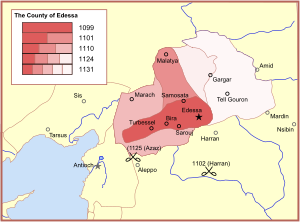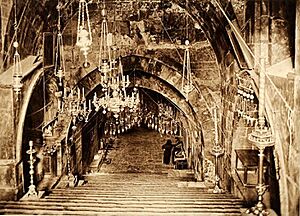Morphia of Melitene facts for kids
Quick facts for kids Morphia of Melitene |
|
|---|---|
| Queen consort of Jerusalem | |
| Tenure | 1118 – c. 1127 |
| Coronation | 25 December 1119 |
| Died | 1 October c. 1127 |
| Spouse | Baldwin II, King of Jerusalem |
| Issue |
|
| Father | Gabriel, Lord of Melitene |
Morphia of Melitene (died around 1 October 1127) was a powerful queen. She was the queen consort of the Kingdom of Jerusalem from 1118 until her death. This kingdom was one of the states set up by Crusaders.
Morphia was Armenian and followed the Greek Orthodox Christian faith. Her father, Gabriel, was a strong leader in northern Syria. He wanted his daughter to marry one of the Crusader leaders. He chose Count Baldwin II of Edessa.
Morphia and Baldwin married around 1100. They had four daughters: Melisende, Alice, Hodierna, and Ioveta. In 1118, Baldwin became the king of Jerusalem. The next year, Morphia became the first woman to be crowned queen of Jerusalem.
She did not take part in daily government. However, she took action to free her husband after he was captured in 1123. Morphia died a few years later. Historians believe her religious beliefs helped Greek Orthodox Christians in the Crusader kingdom.
Contents
Who Was Morphia?
Morphia was the daughter of Gabriel. He was an Armenian prince who ruled the city of Melitene (Malatya) in northern Syria region. Most Armenians belonged to the Oriental Orthodox Armenian Church. But Gabriel and his family were Melkites, who followed the Greek Orthodox faith.
Northern Syria was a very important area for the crusaders. These were Catholics from Western Europe. They had set up new states in the Levant (the eastern Mediterranean) in the late 1000s and early 1100s. Key Crusader leaders, also called Latins or Franks, wanted to marry into Armenian noble families. Armenians were the local Christians who lived in cities between the Byzantine and Seljuk empires.
Gabriel wanted to become allies with Bohemond I of Taranto. Bohemond was a Crusader who had started the Principality of Antioch in 1098. Gabriel offered Morphia's hand in marriage to Bohemond. He also offered the city of Melitene.
But Bohemond was captured while defending Melitene from the Seljuk Turks. So, the marriage did not happen. Instead, another Crusader leader, Baldwin of Bourcq, came to help Gabriel. Morphia married Baldwin.
Morphia's Marriage to Baldwin
Morphia and Baldwin married before the crusade of 1101. Historians think they probably married in 1100. This marriage was very helpful for Baldwin. He had just taken over the nearby County of Edessa, another new Crusader state. Morphia's dowry, which was said to be huge, was also very appealing.
Morphia had three daughters while Baldwin was the count of Edessa. Their names were Melisende, Alice, and Hodierna. In 1103, Morphia's father's land was taken by the Turks. This meant Baldwin no longer had the political advantage from their marriage.
In medieval times, rulers expected their wives to have sons and bring strong alliances. For example, King Baldwin I of Jerusalem, a relative of Baldwin II, sent away his Armenian wife, Arda. She had not given him a son or a useful alliance. Even though Morphia also did not have a son or bring a lasting alliance, Baldwin was very happy with her. He was very dedicated to her. Historian Steven Runciman said their marriage was "a rare sight in the Frankish East, of perfect happiness together."
Becoming Queen of Jerusalem
In 1118, Morphia's husband, Count Baldwin, went on a religious trip to Jerusalem. King Baldwin I died during this trip. Count Baldwin was chosen to become the next king of Jerusalem. At that time, there was no queen in the Kingdom of Jerusalem. King Baldwin I had sent away his last wife, and Morphia was still in Edessa with her daughters.
King Baldwin II waited almost a year and a half to be crowned. He wanted to be crowned together with his wife. In 1119, the king traveled to Edessa. He went to make his cousin Joscelin of Courtenay the new count. He also brought his wife and daughters to Jerusalem.
Baldwin and Morphia's coronation was held on Christmas 1119 in Bethlehem. Morphia was the first queen of Jerusalem to have this special ceremony. The royal couple's fourth and youngest child, another daughter named Ioveta, was born after they became king and queen. This was called being "born in the purple".
As queen, Morphia did not get involved in the daily running of the state. Her name does not appear in any of her husband's official papers. Historian Bernard Hamilton thinks this might have been because of her cultural background. However, Hamilton believes that it was partly thanks to the queen that Greek Orthodox Christians were treated better than other non-Catholic Christians in the kingdom. Only they were allowed daily church services at a large altar in the important Church of the Holy Sepulchre. They also had their own altar at the kingdom's main shrine to Mary, the Church of Our Lady of Josaphat.
A Queen's Brave Actions
Even though she was usually a quiet queen, Morphia showed she could take charge in 1123. Her husband, Baldwin II, and his ally Joscelin were captured by the Muslim Turk leader Belek Ghazi. They were taken to the Harpoot Castle.
The queen hired fifty Armenian soldiers. They pretended to be monks, merchants, and other people. They entered the castle as if they wanted to meet the governor. Once inside, they pulled out weapons from their clothes and took over the guards. Joscelin escaped, but Baldwin decided to try and hold the castle. He was captured again.
In 1124, Morphia traveled to northern Syria with Joscelin. They went to talk about freeing her husband. The amount of money demanded for his release was too high. So, hostages had to be given as a guarantee. Morphia had to give her youngest daughter, four-year-old Ioveta. Joscelin gave his son and heir, Joscelin II. Baldwin was then released. Ioveta and the other hostages were returned in 1125.
Death and Lasting Impact
Queen Morphia died on October 1st. The exact year is not known for sure. Historian Hamilton suggests 1127 or 1128. He notes that her husband, King Baldwin, gave land to the Church of Our Lady of Josaphat in early 1129 "for the rest of her soul."
Morphia was the first queen to die in the Kingdom of Jerusalem. She chose to be buried at the Church of Our Lady of Josaphat. This set a pattern for future queens of Jerusalem to be buried there. Kings, however, were buried in the Church of the Holy Sepulchre.
Historian Hans Eberhard Mayer believes Morphia died on October 1, 1126 or 1127. He thinks 1126 is more likely. In that year, the king was a widower and had no sons. He began to plan for his daughters to take over the throne. It was decided that the oldest daughter, Melisende, would become queen after Baldwin.
Alice, the second oldest, married Prince Bohemond II of Antioch in October 1126. The third daughter, Hodierna, married Count Raymond II of Tripoli by 1138. Mayer thinks they might have been promised to each other as early as 1127. Finally, a group was sent to Count Fulk V of Anjou in late 1127 or early 1128. They went to arrange his marriage to Melisende. The young Ioveta was sent to a nunnery. Because of these marriages, the ruling families of three of the four Crusader states now had "Armenian blood."
Melisende, who became queen in 1131, was influenced by Morphia's Greek Orthodox faith. The Melisende Psalter is a book that combines Western and Byzantine art styles. It is an example of how art mixed in the Crusader states. This happened because local Christians and European newcomers met and married.



